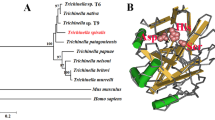Abstract
Fasciola gigantica saposin-like protein-2 (FgSAP-2) belongs to a family of lipid-interacting proteins that are involved in the cytolysis of target cells. In this study, we have cloned and expressed FgSAP-2 and produced the antibody against this recombinant protein. Rabbit antiserum against rFgSAP-2 reacted with a similar native protein in the whole body extracts of the 4-week-old juvenile and adult stage, as well as a protein in their excretion–secretion, but not in the tegument. In situ hybridization and immunofluorescence detection revealed the presence of SAP-2 mRNA transcripts and proteins in the cecal epithelial cells of 4-week-old juvenile and adult parasites, but not in the metacercariae and newly excysted juveniles. Moreover, SAP-2 is present only in the cecal epithelial cells lining the distal part of the digestive tract, but not in the tegumental-type epithelium lining the proximal part of the digestive tract. The rFgSAP-2 reacted with antisera from rabbits infected with F. gigantica metacercariae collected at 5 weeks, but not at 2 weeks after infection. Anti-rFgSAP-2 did not exhibit any cross-reactivity with the other parasites' antigens, including Opisthorchis viverrini, Eurytrema pancreaticum, Cotylophoron cotylophorum, Fischoederius cobboldi, Gigantocotyle explanatum, Paramphistomum cervi, Setaria labiato-papillosa, and Haemonchus placei. This finding indicated that SAP-2 is a unique protein that is expressed only in late juvenile and adult F. gigantica, and it could be considered for immunodiagnostic and as a vaccine candidate for fasciolosis.






Similar content being viewed by others
References
Bruhn H (2005) A short guided tour through functional and structural features of saposin-like proteins. Biochem J 389:249–257
Espino AM, Hillyer GV (2003) Molecular cloning of a member of the Fasciola hepatica saposin-like protein family. J Parasitol 89:545–552
Espino AM, Hillyer GV (2004) A novel Fasciola hepatica saposin-like recombinant protein with immunoprophylactic potential. J Parasitol 90:876–879
Espino AM, Osuna A, Gil R, Hillyer GV (2005) Fasciola hepatica: humoral and cytokine responses to a member of the saposin-like protein family following delivery as a DNA vaccine in mice. Exp Parasitol 110:374–383
Grams R, Adisakwattana P, Ritthisunthorn N, Eursitthichai V, Vichasri-Grams S, Viyanant V (2006) The saposin-like proteins 1, 2, and 3 of Fasciola gigantica. Mol Biochem Parasitol 148:133–143
Meemon K, Grams R, Vichasri-Grams S, Hofmann A, Korge G, Viyanant V, Upatham ES, Habe S, Sobhon P (2004) Molecular cloning and analysis of stage and tissue-specific expression of cathepsin B encoding genes from Fasciola gigantica. Mol Biochem Parasitol 136:1–10
Meemon K, Khawsuk W, Sriburee S, Meepool A, Sethadavit M, Sansri V, Wanichanon C, Sobhon P (2010) Fasciola gigantica: histology of the digestive tract and the expression of cathepsin L. Exp Parasitol 125:371–379
Reed MB, Strugnell RA, Panaccio M, Spithill TW (2000) A novel member of the NK-lysin protein family is developmentally regulated and secreted by Fasciola hepatica. Mol Biochem Parasitol 105:297–303
Sethadavit M, Meemon K, Jardim A, Spithill TW, Sobhon P (2009) Identification, expression and immunolocalization of cathepsin B3, a stage-specific antigen expressed by juvenile Fasciola gigantica. Acta Trop 112:164–173
Sordillo LM, Kendall JT, Corl CM, Cross TH (2005) Molecular characterization of a saposin-like protein family member isolated from bovine lymphocytes. J Dairy Sci 88:1378–1390
Yang L, Johansson J, Ridsdale R, Willander H, Fitzen M, Akinbi HT, Weaver TE (2010) Surfactant protein B propeptide contains a saposin-like protein domain with antimicrobial activity at low pH. J Immunol 184:975–983
Acknowledgements
This research was supported by a grant from Mahidol University to Prasert Sobhon and TRF-CHE Research Grant for New Scholar to Krai Meemon.
Author information
Authors and Affiliations
Corresponding author
Rights and permissions
About this article
Cite this article
Kueakhai, P., Meemon, K., Changklungmoa, N. et al. Characterization and localization of saposin-like protein-2 (SAP-2) in Fasciola gigantica . Parasitol Res 108, 1493–1500 (2011). https://doi.org/10.1007/s00436-010-2201-7
Received:
Accepted:
Published:
Issue Date:
DOI: https://doi.org/10.1007/s00436-010-2201-7




